Tuesday, October 31, 2017
Face Processing in Japanese and Sign Language Speakers
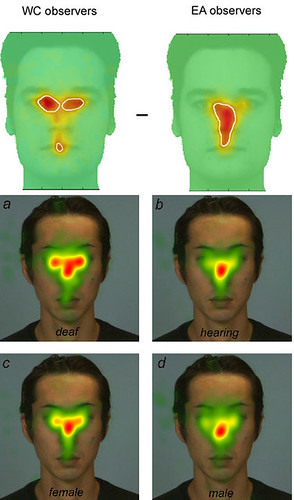
Roberto Caldara and associates find that when recognising faces, Westerners tend to triangulate (in a manner of speaking) analysing the face moving their gaze from eye to eye to mouth, whereas East Asians seem to process faces globally and holistically, perhaps, by focusing upon the nose (upper two images, Miellet, Vizioli, He, Zhou, & Caldara, 2013, p.6).
Bearing in mind that in Lubna Ahmed as yet unpublished research, showing that repeating numbers impedes Westeners but does not reduce the facial processing ability of Japanese, and that repeating numbers impedes analytical but does not impede global processing of Navon figures (Ahmed & W de Fockert, 2012) , conversely improving global recognition, and crossing these results with the fact that research repeating the alphabet is the way of preventing self-talk (Kim, 2002), I presumed that all this demonstrated that East Asian global/holistic face processing is also non-linguistic processing, or conversely that Western triangulation is linguistic processing -- looking for nameable features -- which is impeded by being made to remember and presumably repeat numbers.
Caldera also introduces research (lower four images above from Watanabe, Matsuda, Nishioka, & Namatame, 2011, p.4) that demonstrates that the deaf and women are more likely to use the Western, 'triangulating' style of facial processing, whereas non-deaf and males seem to use the global style method of focussing on the nose. Noted elsewhere the Japanese should resemble the deaf if they are really not whispering -- thinking in words. So why is it that the deaf are using the Western style of face processing?
I think that this further reversal is due to the type of information being processed. The upper image is of Westerner and East Asians recognising the identities of faces whereas the lower four images are of deaf and non deaf, males and females processing emotions.
Emotions and identities may be being processed in opposite ways. As Caldera and colleagues point out (Stoll et al., 2017) the deaf use their faces to speak, so facial expressions and perhaps also emotions of the deaf are more likely to be processed linguistically using the triangulation method. Identities on the other hand are seen as linguistic by Westerners and the non-deaf who process the identities of faces in such a way as enwordify them, where as the Japanese (and I predict the deaf) see identify in the face itself (Watsuji, 2011). In other words, if Matsuda, Nishioka, & Namatame repeated their research except asking deaf and hearing subjects to identify facial identities, I predict they would have found the opposite tendency.
Caldera has further also performed some further fascinating research (Stoll et al., 2017) that finds that both deaf and non-deaf people who use sign language process faces in a different way.
Bingo.
I think that this explains the meaning of Kata, the forms used in everything from Karate to tea ceremony, by which I presume Japanese learn to be Japanese (based on hints from Masamune, Butler, 1993; and Yamamoto, 2009). Kata forms are like sign language by means of which the Japanese learn to speak with their bodies. The Japanese speak at shrines where they clap, and in the kata of martial arts and tea ceremony training rooms, with their bodies. The Japanese have bodies that speak. For the Japanese, this allows them to realise that speaking takes place on the outside of the head, on the forehead even, and this may be how the curse, of the whispering, can be lifted.
I am always attempting to leap to the conclusion.
And, there is a problem with the above line of reasoning in that Lubna Ahmed's unpublished research which showed that repeating numbers did not impede Japanese facial recognition, was upon the recognition of emotions in faces. According to the above reasoning, it is the Japanese who should be impeded if, like the deaf, they are processing emotion in an analytical way.
However, that the differences exhibited by Westerners and East Asians are beginning to be demonstrated in differences between deaf and hearing, and people memorising digits and those who are not, suggests at least tentative support for the Nacalian turn.
Images are from upper two images, Miellet, Vizioli, He, Zhou, & Caldara, 2013, p.6 and Watanabe, Matsuda, Nishioka, & Namatame, 2011, p.4.
お取り下げご希望の場合は下記のコメント欄か、http://nihonbunka.comで掲示されるメールアドレスにご一筆ください。 Should anyone want me to cease and desist, please leave a comment or contact me from the email link at nihonbunka.com
Bibliography
Ahmed, L., & W de Fockert, J. (2012). Working Memory Load Can Both Improve and Impair Selective Attention: Evidence from the Navon Paradigm. Attention, Perception & Psychophysics, 74, 1397–405. doi.org/10.3758/s13414-012-0357-1
Butler, J. (1993). Bodies That Matter: On the Discursive Limits of "Sex. Routledge.
Miellet, S., Vizioli, L., He, L., Zhou, X., & Caldara, R. (2013). Mapping Face Recognition Information Use across Cultures. Frontiers in Psychology, 4, 34. doi.org/10.3389/fpsyg.2013.00034
Stoll, C., Palluel-Germain, R., Caldara, R., Lao, J., Dye, M. W. G., Aptel, F., & Pascalis, O. (2017). Face Recognition is Shaped by the Use of Sign Language. The Journal of Deaf Studies and Deaf Education, 1–9. doi.org/10.1093/deafed/enx034
Watanabe, K., Matsuda, T., Nishioka, T., & Namatame, M. (2011). Eye Gaze during Observation of Static Faces in Deaf People. PLOS ONE, 6(2), e16919. doi.org/10.1371/journal.pone.0016919
Watsuji, T. (2011). Mask and Persona. Japan Studies Review, 15, 147–155.
Yamamoto, I., 山本一輝. (2009). メンタルトレーニング~弓道を通じた自己イメージのあり方~(Mental Training: The way of self imaging achieved through Japanese Archery) (未発表卒論). 山口大学経済学部観光政策学科.
Labels: japanese culture, Nacalian, nihonbunka, 日本文化
No Confidence in their Smile?

The Japanese are about one third as likely to say that they are confident in their smile (Funaki, 2006, p.29), because I believe and as Hamaguchi, Takemoto and Tobimatsu (in preparation) demonstrates, the Japanese express their confidence with their smile not about it.
Takemoto, Hamaguchi, & Tobimatsu .(in preparation). The Japanese smile as a symbol of positive self-regard.
舩木純三. (2006). クリニカル 笑顔の効用とスマイルトレーニングの必要性. 日本歯科医師会雑誌, 59(7), 631-639.
sunano.whitesnow.jp/pdf/smile-traning.pdf
Labels: japanese culture, Nacalian, nihonbunka, 日本文化
Heroes: All Mouth and No Mouth At All

Western superheroes sometimes show their faces, like Superman and sometimes have a full faced mask like Iron man but when they wear a partial mask it always shows their mouth. They appear to be all mouth. On the other hand, Japanese super heroes often have no mouth at all. The mouth and the spoken word is not very important, or even avoided, in Japan but Westerners and their heroes are their pronouns, names and self-narratives. With heroes this different there may be reason to be concerned.
Derrida believes that the war to end all wars will be waged in the name of the name.
"But as it is in the name of something whose name, in this logic of total destruction, can no longer be borne, transmitted, inherited by anything living, that name in the name of which war would take place would be the name of nothing, it would be pure name, the "naked name." That war would be the first and the last war in the name of the name, with only the non-name of "name." It would be a war without a name, a nameless war, for it would no longer share even the name of war with other events of the same type, of the same family. Beyond all genealogy, a nameless war in the name of the name. That would be the End and the Revelation of the name itself, the Apocalypse of the Name. "(Derrida, 1984, p.30-31)
Western Heroes
Citizen V
Spectre
Phantom of the Fair
American Crusader
Keen Detective
Fighting Yank
Hawkgirl
Hawkman
Grim Reaper
Ray
Arrow
Green Mask
The Black Terror
Cat Man
Black Owl
Blue Beetle
New Invaders
Blue Diamond
Captain America
Batman
Father Time
Green Hornet
Flame
Blonde Platinum
Golden Girl
Captain Courageous
Mystic
Crimson Avenger
Japanese Heroes
Masked Riders
Ultramen (mouths suggested, but unmoving and non functional. They express the identity of the ultraman but do not speak.)
Super Sentai
Hell0 Kitty
Gundam
Evangelion
Derrida, J. (1984). No Apocalypse, Not Now (full speed ahead, seven missiles, seven missives). Translated by C. Porter, & P. Lewis, diacritics, 14(2), 20-31. www.uni-giessen.de/faculties/gcsc/media/workshop-feminism...
Labels: japanese culture, Nacalian, nihonbunka, superhero, 日本文化
Indentity: Asians Lower, Westerners Upper
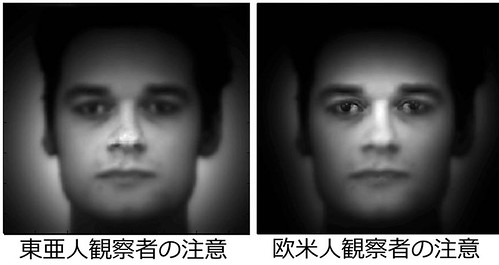
When learning identity, Asians look at the nose and the lower part of the face (above left) whereas Westerners look at the eyes and mouth, triangulating, comparatively focussing more on the upper part of the face (above right).
This is the opposite as I would have predicted bearing in mind that Japanese thieves (dorobo) traditionally used a wrapping cloth to cover the upper part of their face (other than their eyes), whereas Western outlaws traditionally covered the lower part of their face with their scarf.
It is also the opposite of the part of the face that East Asian and Western children use to recognise emotions. I argue that the way in which emotion and identity are perceived may be swapped East to West.
Miellet, S., Vizioli, L., He, L., Zhou, X., & Caldara, R. (2013). Mapping Face Recognition Information Use across Cultures. Frontiers in Psychology, 4, 34. doi.org/10.3389/fpsyg.2013.00034
Labels: japanese culture, Nacalian, nihonbunka, 日本文化
East Asian Children Look at Eyes to Sense Emotion

Since Yuki, Maddux and Masuda (2007) we know that Westerners and Asians look at different parts of the face when discriminating and processing emotions. We now know that even in seven month old children, East Asian children fixate on the eyes even or especially when looking at happy faces, whereas Western children look at mouths as illustrated in the image above (Geangu, et al., 2016, p. R663).
お取り下げご希望の場合は下記のコメント欄か、http://nihonbunka.comで掲示されるメールアドレスにご一筆ください。 Should you wish that I cease and desist, please leave a comment here, at flickr, or send me an email to the link on my homepage http://nihonbunka.com
Geangu, E., Ichikawa, H., Lao, J., Kanazawa, S., Yamaguchi, M. K., Caldara, R., & Turati, C. (2016). Culture shapes 7-month-olds’ perceptual strategies in discriminating facial expressions of emotion. Current Biology, 26(14), R663-R664. 下記URL2017/10/28参照 www.sciencedirect.com/science/article/pii/S0960982216306054
Yuki, M., Maddux, W. W., & Masuda, T. (2007). Are the windows to the soul the same in the East and West? Cultural differences in using the eyes and mouth as cues to recognize emotions in Japan and the United States. Journal of Experimental Social Psychology, 43(2), 303-311.
Labels: japanese culture, Nacalian, nihonbunka, 日本文化
Washida is Not his Face, Body or Clothes
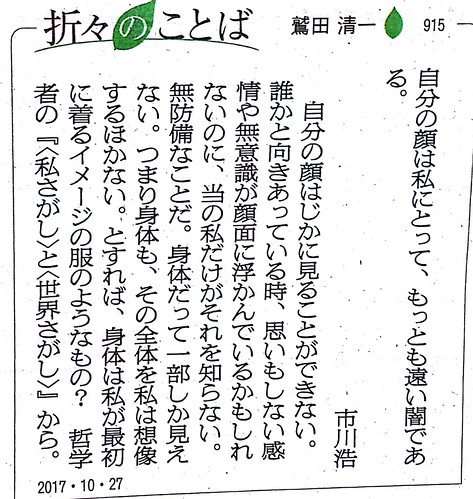
Professor Seichi Washida (2017) often rails against the centrality of face in Japanese perceptions of self (Watsuji. 2011). In this short piece on the front page of the Asahi Newspaper, Washida quotes Ichikawa Hiroshi, who in fact argues the unity of mind and body (Ichikawa, 1975) as saying that this face is that which is farthest from himself. I think perhaps Ichikawa draws a destinction between face, which can not be seen, and the body that can and the place in which it is perceived. Despite this fact, Washida does not distinguish between the body and face, and asks "is the body the first image clothes I wear perhaps?" This metaphor relating the body with clothing can be use to theorize superheroes who are light (Ultraman) or their clothes (Sentai/Power Rangers, Kamen/ Masked riders, Gundam, Eva, and Iron Man). Japanese people, as they become Japanese, grow into their clothes. Professor Washida remains unconvinced.
お取り下げご希望の場合は下記のコメント欄か、http://nihonbunka.comで掲示されるメールアドレスにご一筆ください。
Washida, S. 鷲田清一.(2017/10/27).折々のことば915.朝日新聞朝刊.
市川浩. (1975). 精神としての身体. 勁草書房.
Labels: japanese culture, nihonbunka, Super-Sentai, superhero
One Reason Japanese Waiters Shout
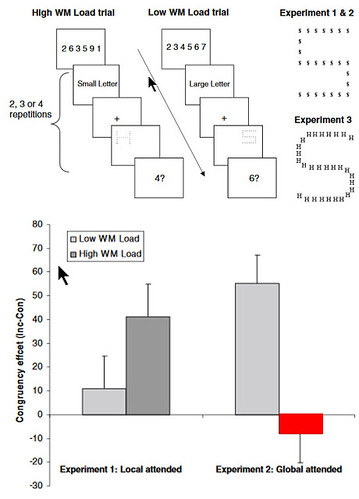
apanese waiters, and Karate practioners, shout as they go about their business. They shout "Welcome" to the customers, and sometimes even shout out the customers orders such as "An extra helping of Ramen!" in voice loud enough for the clientee and staff in the whole restaurant to hear. There are a number of reasons why they are doing this, including the fact that such shouting is approved of by the majority of Japanese customers. Additionally it may the the case that shouting makes them better at their job.
Lubna Ahmed and a colleague (Ahmed & W de Fockert, 2012) gave subjects one of two low difficulty and high difficulty memory tasks, before asking them to respond with either the small or large letter represented by a Navon figure. In the low load condition, the numbers that the subjects remembered where consecutive ascending, whereas in the high load condition the numbers were random. I suggest that the random, but not consecutive number condition, the subjects usually resorted to the typical phone-number memory method of repeating the digits. Under t his condition they became faster at recognising the large letter represented by a Navon figure: "S" in the case of the figure above right. This is because repeating the digits loaded and turned off the linguistic analytical mind, leaving them to react naturally and more quickly to the globally presented "S." Waiter's likewise, whose job it is to attend to the needs of a restaurant full of customers, and Karate practitioners who need to react with speed to movements of an opponent, can benefit from loading their linguistic brain, allowing to respond rapidly, naturally and in a Western sense mindlessly.
The above image is adapted from (Ahmed & W de Fockert, 2012, Fig. 1 and Fig. 2. on p. 1399 and p. 1400 respectively)
Ahmed, L., & W de Fockert, J. (2012). Working memory load can both improve and impair selective attention: Evidence from the Navon paradigm. Attention, Perception & Psychophysics, 74, 1397–405. doi.org/10.3758/s13414-012-0357-1
Labels: japanese culture, Nacalian, nihonbunka, 日本文化
Individualist Rucksacks
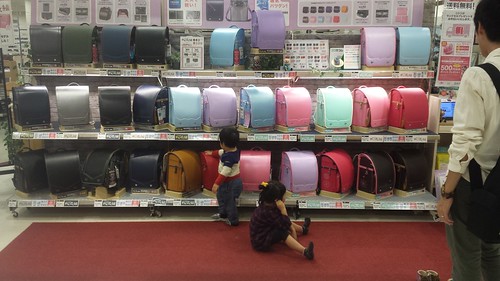
Traditionally these lightweight, stiff rucksacks for primary school children called randoseru, from the Dutch word ransel, came in only two colours: black for boys and red for girls. The colour coding of boys and girls rucksacks continued for more than 100 years since their introduction in 1885 (Penttinen, 2011). Due to the uniformity of their colour and design the use of randoseru has been described as part of the process of "inculcating group values"(Samovar, Porter, & McDaniel, 2011, pp. 402).
Each weekday morning small groups of elementary school students assemble near their homes and set out for their school house in classic military platoon formation... They also carry the ubiquitous backpack (randoseru), identifiable throughout Japan in shape and size and differing significantly in only the color —predominately red and black, but occasionally another color. The back packs mark the wearers as elementary students and the hats denote the school attended.
(Ibid, pp. 402-403)
In the 1990s, however, with the advent of feminism and increasing individualism there was pressure on schools and randoseru makers to provide rucksacks in other colours. It is only in the past decade that non-black non-red randoseru have become popular. A Google image search for images of randoseru stipulating before 2010 shows rucksacks in predominantly the two traditional colours. Primary school children now commonly wear rucksacks in all the colours shown here.
Penttinen, L. (2011) A Research Upon School Uniforms and Personal Style. epublications.uef.fi/pub/urn_nbn_fi_uef-20110453/urn_nbn_...
Samovar, L. A., Porter, R. E., & McDaniel, E. R. (2011). Intercultural Communication: A Reader. Cengage Learning.
Labels: japanese culture, Nacalian, nihonbunka, 日本文化
Speaking in Pictures
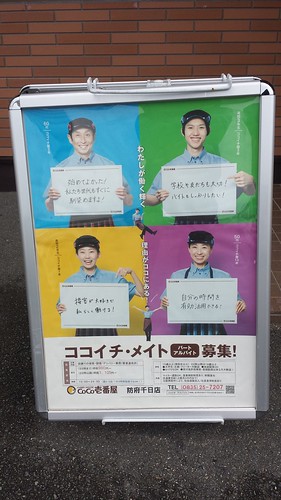
Like the Heptapod in Arrival (2016), the Japanese speak in pictures in adverts like this, on game shows, using smilies, smiles, and large number of other signs, and to a greater extent than Westerners believe language to be external to the mind. Their language is, like their smiles, a gesture or sign to others, and even their first person pronoun is no more or less than a you for you (Mori, 1999) and is not accompanied by a giant, uncanny ear (Nietzsche, see Derrida & McDonald, 1985). That said, Sadako looks out of their eyes (Nishida, 1939; Mumon, 1228).
Derrida, J., & McDonald, C. (1985). The Ear of the Other: Otobiography, Transference, Translation: Texts and Discussions with Jacques Derrida. New York: Schocken Books.
Mori, A. 森有正. (1999). 森有正エッセー集成〈5〉. 筑摩書房.
Mumon, E. (1228). "Koan 42. The Girl Comes Out from Meditation". The Gateless Gate. Poor translation "One wears the mask of god, one a devil's mask." should be just, "God head and Devil mask" afaik. Retrieved from
Nishida, K. (1939). 絶対矛盾的自己同 一(Absolutely Contradictory Self Identity) www.aozora.gr.jp/cards/000182/files/1755.html
www.sacred-texts.com/bud/zen/mumonkan.htm
Labels: japanese culture, Nacalian, nihonbunka, 日本文化
Friday, October 06, 2017
Stopping Momentarily (Ittanteishi)

All vehicles stop momentarily (ittanteishi 一旦停止) to check for approaching trains, before crossing railway level crossings even if the barrier is up and the lights are in their favour. This stands in contrast to the fact that even in Japan one is not required to stop ones vehicle momentarily to see if anyone is running a red light at green traffic lights.
Once a long time ago I asked a university professor why the Japanese university professor why this is the case. He suggested that it could be due to the emperor system (which was his axe to grind) such that common folk are required to pay respect to any representative of Japan (such as JR trains) since they are also therefore representatives of, or represented by, the "symbolic emperor". At the time I thought, "surely not" but upon reflection it occurs to me that this practice of paying deference to representatives of the state has a long history.
Consider the Namamugi incident of 1862 where three Britons who refused to dismount to allow the procession of the Lord of Kagoshima (then Satsuma) to pass where attacked by attendant samurai swordsmen who expected deference from commoners, even British ones. Far further back in time the Wajinden or 'Records of Wei', written by Chinese visitors to ancient Japan in the early 6 century, recorded the fact that commoners would move to the side of the road and bow at the passing of aristocracy. 1500 years later the Japanese are still paying their respect to the passing of representatives of the polity, in the form of trains at level crossings.
From a logical point of view, I can see how it could be more important to stop at level crossings rather than at traffic lights if the vehicle stopping has the power to derail the train containing large number of people, resulting in large number of causalities. This could happen in the case of trucks and large cars, but it is difficult to imagine in the case of light cars

and surely cyclists would be simply swatted off the rails like mosquitoes should they venture onto the tracks at an importune time.

I can therefore think of no logical reason why cyclists should be made to stop momentarily and check for approaching trains at level crossings, but not at green traffic lights. But there is something beautiful about it, so I do it anyway.
Labels: japan, japanese culture, 日本文化
This blog represents the opinions of the author, Timothy Takemoto, and not the opinions of his employer.
